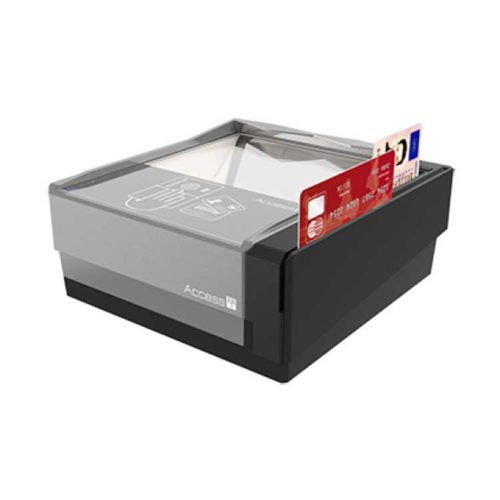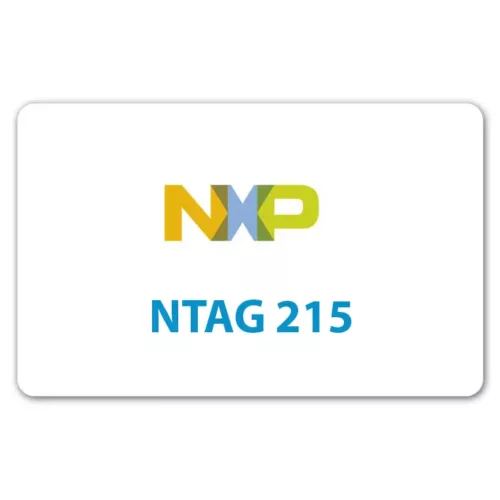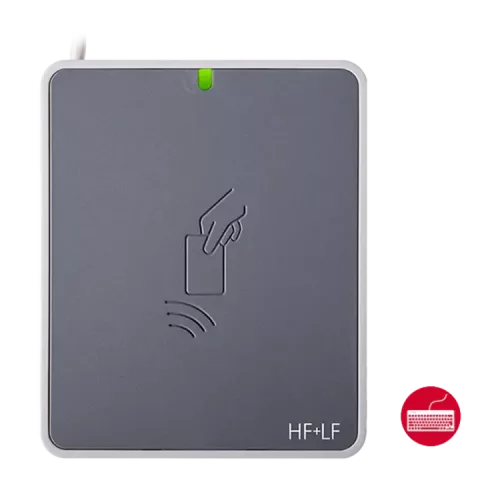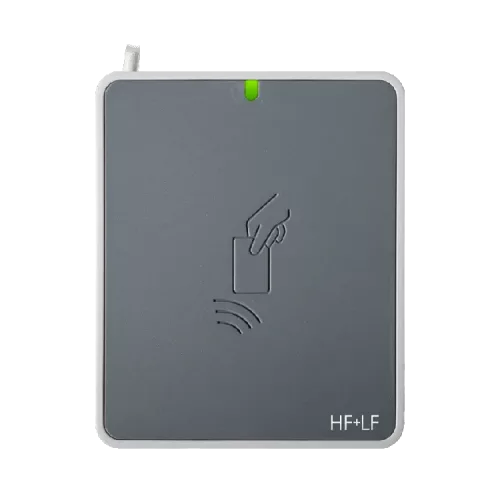NFC tags or Near-Field Communication tags are passive devices such as a smart card that can be used to communicate with active NFC devices (an active NFC reader/writer). The NFC tags can be used within applications such as posters, and other areas where small amounts of data can be stored and transferred to active NFC devices. Within the poster the live area can be used as a touch point for the active NFC device. NFC tags communicate using the ISO 14443 type A and B wireless standards, which is the ISO standard for contact-less smartcards, used on many public transportation systems. This is why NFC devices can be used with existing contact-less technologies, such as card payment points.
Size and format
The most common form of NFC tag is sticker, which is a label that contains the circuit and the antenna. Thanks to their small size, however, NFC tags can be easily integrated into multiple supports, such as a card, a wristband, a key ring, a gadget, etc. An object equipped with NFC Tag can be uniquely identified thanks to the unique code of the chip. Most modern smartphones with NFC capability and support peer-to-peer mode can emulate an NFC tag, essential making the phone a tag.
Memory
The available memory of NFC tags varies according to the type of chip, but generally in the most common ones it is less than 1 kilobyte. This may seem like a limitation, but in reality only a few bytes are enough to get amazing functions, thanks to the NDEF standard, the data format for the NFC encoded by the NFC Forum. One of the most common functions in marketing, for example, is the programming of a URL that refers to a web page. The Tag, so programmed, can be applied to any object, brochure, flyer. With this function, they are similar to a QR Code, but are equipped with a greater data capacity, which makes them useful in the case of reports and campaign analysis. In addition, they can be customized with their own graphics and do not require, at least for Android, any application to be read. In addition, the memory of an NFC Tag is divided into several blocks, which can be used for the development of more complex applications (inventory, medical card, etc.).
Communication
Tag Types
There are a range of different tag types available, each offering different storage levels and transfer speeds. Tag types 1 and 2 come with capacities between just a tiny 48 bytes and 2 kilobytes of data, and can transmit that information at just 106 kbit/s. Although that may sound quite small, especially compared to your typical SD card, that’s enough data for some very simple pieces of information, such as a website URL, and is all you need for most basic NFC tags. These tags are designed to be highly cost effective, and can also be re-used if you want to change the data stored on them.
Type 3 uses a different Sony Felica standard, and can transfer data at a slightly faster 212 kbit/s. These tend to be used for more complicated applications, but sadly can’t be rewritten. Similarly, type 4 is again read-only, but has a larger memory capacity of up to 32 kbytes and communication speeds of between 106 kbit/s and the maximum NFC 424 kbit/s. Tag type 4 works with both type A and B of the ISO14443 standard.
Power Supply
NFC tags are passive devices that use electromagnetic induction, which means that they operate without a power supply of their own and are reliant on an active device to come into range before they are activated, because they are activated directly by the magnetic field of the NFC sensor of the mobile phone or the device that reads them.
Unique ID
All NFC Tags have a unique code, called UID (Unique ID), located in the first 2 pages of the memory, that are locked (can not be changed nor deleted). Through the UID, you can uniquely pair an NFC Tag to an object or a person, and develop applications that identify and interact with them.
The NDEF format
Then there are other types of commands, which we can define as “standard”, because they use the NDEF format (NFC Data Exchange Format), defined by the NFC Forum specifically for the programming of NFC tags. To read and run these types of commands on a smartphone, in general, no apps are installed on your phone. The iPhone exceptions. The commands defined as “standard” are the following:
- open a web page, or a link in general
- open the Facebook app
- send emails or SMS
- start a phone call
- simple text
- save a V-Card contact (even if it is not a universal standard)
- start an application (only applies to Android and Windows, made with the relative operating system)
Given the transversal nature of these applications, they are often used for marketing purposes.
Related Products
Related Articles
ViVOtech & G&D Confirm Interoperability Between G&D NFC-Enabled SIM Cards And ViVOtech’s OTA NFC Infrastructure Software
ViVOtech And Giesecke & Devrient (G&D) Confirm Interoperability Between G&D NFC-Enabled SIM Cards And ViVOtech's Over-The-Air (OTA) NFC Infrastructure Software Munich, Germany and Santa Clara, CA - Continuing to deliver the latest technologies for powering the most flexible and open
BIO-key Announces New MobilePOS Pro Android All-in-one Terminal Enabling Convenient Biometric-Secured Commerce
WALL, N.J., Aug. 18, 2021 -- BIO-key International, Inc. (NASDAQ: BKYI), an innovative provider of civil, workforce and customer identity and access management (IAM) solutions featuring Identity-Bound Biometrics, today announced the availability of BIO-key MobilePOS Pro, a handheld, biometrically-enabled, rugged
Chainway Launches C66 Mobile Computer with High Extensibility
May 13, 2019 -- Chainway, a global provider of data collection products and solutions, recently launched C66, a new industrial-grade handheld computer. With compact and ergonomic design, this device features overall improvement on configuration and capability like larger screen, removable battery
Shufti Pro Launches NFC Verification to Simplify Identity Verification Workflow
London, United Kingdom, April 13, 2021 -- Shufti Pro, an AI-powered identity verification service provider has launched a new product, NFC Verification, to enhance its IDV process. NFC verification by Shufti Pro uses Near field Communication technology to swiftly
Versatile and contactless: Infineon sets standards with multifunctional employee ID card including Mastercard payment function
Munich, Germany – 18 January 2021 – Infineon Technologies AG (FSE: IFX / OTCQX: IFNNY) is replacing the employee ID cards at its headquarters 'Am Campeon' with the world’s first solution that combines highly secured office building access with
Access-IS announce the OEM integration of its TripTick ticket reader and ATOM ADR300 document scanner with CCM’s Hybrid Self Service Bag-Drop counter
August 26, 2020 - Rather than choosing lines of either manned or unmanned counters, airport operators can configure the check-in hall according to the needs of that hour, day, week or even flight. The number of manned counters required increases




